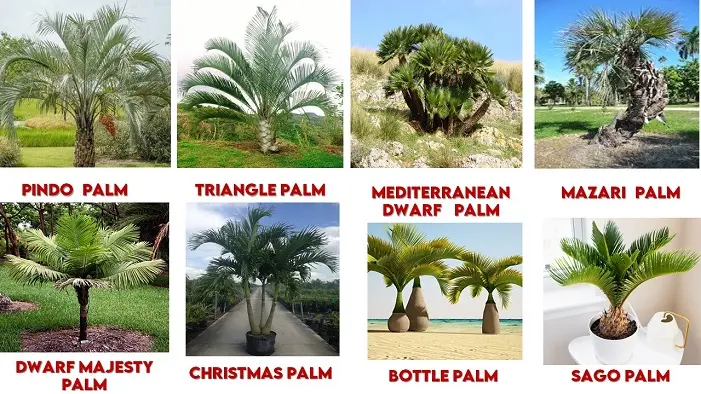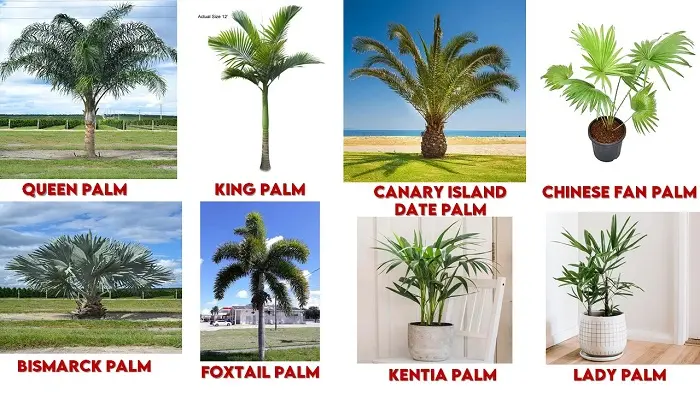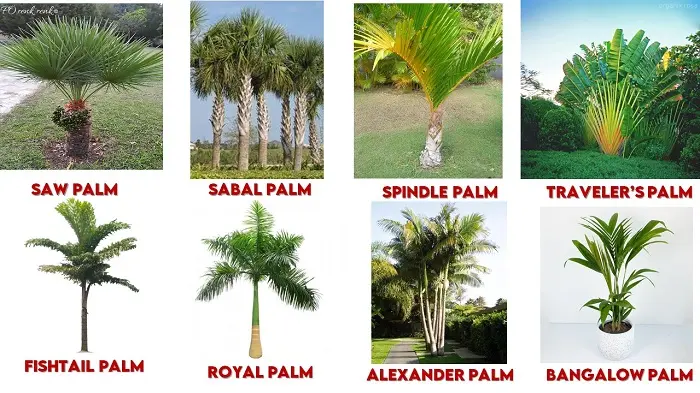Palm trees are a common sight in dry, desert regions around the world. They are often seen in deserts and dry regions. So palms are definitely a great choice when it comes to selecting plants for your garden. Today we will be discussing about 35 different types of palms that you can choose from to beautify your garden.
Different Types of Palm Trees
1. Date Palm
Botanical name: Phoenix dactilifera
The number 1 on the list of types of Palm trees is the Date Palm a regal palm known for its delicious fruits. This evergreen palm can grow up to 15m in height and has a spread of 5m. The palm produces panicles of pale yellow flowers in the spring, which give way to the edible oblong fruits, the dates.
The Date Palm thrives in full sun or partial shade and is drought-tolerant. The palm prefers hot, dry, and sunny conditions, with temperatures around 95 degrees Fahrenheit for pollination. Despite its drought tolerance, it should have even moisture during its flowering and fruiting season.
2. Areca Palm
Botanical name: Dypsis lutescens
Also known as the Butterfly Palm, it is one of the most popular types of palm trees in India. The palm can grow up to 1.8 to 9 meters tall with a spread of 2.5 to 3 meters. It grows effectively in partial sunlight and likes high humidity (50%-70%) for healthy growth.
The Areca Palm prefers moist and well-drained soil with temperatures ranging from 18 to 24 degrees Celsius. It should be watered at a moderate rate about 2-3 times per week in the growing seasons.
3. Mexican Fan Palm
Botanical name: Washingtonia robusta
The Mexican Fan Palm is a tall and fast-growing palm tree, known for its large, fan-shaped leaves. It’s characterized by its slim, straight trunk, and large, fanning fronds that rest atop the trunk. The Palm prefers full sun and well-draining, fertile soil. It can withstand temperatures down to -6.67°C, but not for extended periods. It’s best to give them a wide berth of space since they grow a large root structure.
4. European Fan Palm
Botanical name: Chamaerops humilis
The European Fan Palm is a cold-hardy palm tree that can tolerate temperatures as low as -12.22°C. It can grow both as a shrub with multiple trunks or as a small tree with a single trunk. The light blue-green to silver-green, fan-shaped fronds stretch roughly 0.6 meters long and wide and feature 10 to 20 long, narrow leaflets.
In terms of growth requirements, the European Fan Palm thrives in full sun but can tolerate partial shade. Until the roots of a young European Fan Palm are established, they should be watered to maintain even soil moisture. Mature European Fan Palms are moderately drought-tolerant.
5. Windmill Palm
Botanical name: Trachycarpus fortunei
This is one of the popular palm trees varieties in the world. It is a hardy palm tree that can withstand temperatures as low as 10 degrees Fahrenheit. The palm’s flowers turn into fruit after blooming, however, it is not edible.
The Windmill Palm prefers a semi-shade or shady location but will tolerate full sun in more northern climates. It grows best in loamy and/or sandy soil with good drainage. Watering should be done weekly once established. It also needs a slow-release fertilizer twice a year: first in the spring, then again in summer or fall.
6. Pygmy Date Palm
Botanical name: Phoenix roebelenii
This palm which is native to South Africa is a small, slow-growing palm tree. It’s often grown in containers so it can be moved to a frost-free area over winter. In terms of growth requirements, the Pygmy Date Palm thrives in bright, indirect sunlight. It prefers warm temperatures and does not tolerate temperatures below -3°C. The palm likes moisture in the air around it and is happiest when humidity is high. The palm enjoys plenty of sunshine but will not tolerate harsh, direct sun.

7. Pindo Palm
Botanical name: Butia capitata
The Pindo Palm, scientifically known as Butia capitata, is a slow-growing palm native to South America. Its long, feathery fronds add a tropical feel to any space. Once established, it becomes drought-tolerant. However, during its initial establishment, it should be watered regularly.
8. Triangle Palm
Botanical name: Dypsis decaryi
This one is a unique palm tree that hails from the island of Madagascar. This palm can reach a height of 4.5 to 7.5 meters and a width of 3 to 4.5 meters. It’s quite adaptable and can tolerate both moist and dry soil. However, it’s important to let the soil dry out a bit between waterings. The Triangle Palm appreciates a quarterly feed with a balanced houseplant fertilizer or palm fertilizer.
9. Mediterranean Dwarf Palm
Botanical name: Chamaerops humilis
The Mediterranean Dwarf Palm is a shrub-like, clumping palm with several stems growing from a single base. It’s one of the most cold-hardy palms and can withstand temperatures up to -12 degrees Celsius.
It needs about 200 milliliters of water every 9 days. It loves being close to bright, sunny windows and does not tolerate low light. It’s generally easy to care for and is fairly drought-tolerant once established. It can grow at a rate of 30 centimeters per year when given full sunlight daily. Properly cared for, it can grow up to 4.5 meters tall and wide.
10. Mazari Palm
Botanical name: Nannorrhops ritchiana
The Mazari palm, also known as the Mazari dwarf palm, is a hardy and drought-tolerant palm native to the arid regions of Afghanistan and Pakistan.
To thrive, Mazari palms require well-drained soil with a pH range of 7 to 8, preferably sandy or loamy soil. Regular watering is necessary during the establishment phase, but once established, they are highly drought-resistant, needing minimal irrigation. Additionally, periodic pruning of dead or damaged fronds helps maintain its aesthetic appeal and promotes healthy growth.
11. Dwarf Majesty Palm
Botanical name: Ravenea hildebrandtii
Originating from Madagascar, this palm typically grows to a height of 1.5 to 2 meters with a spread of 1 to 1.5 meters, making it suitable for small gardens, balconies, and indoor spaces. Its gracefully arching fronds, adorned with delicate green leaflets, add a tropical touch to any landscape.
Dwarf Majesty Palms require well-drained soil with a pH range of 6 to 7 and regular watering to keep the soil consistently moist but not waterlogged. They prefer partial shade to full sunlight and are sensitive to cold temperatures, thriving best in warm and humid climates.
12. Christmas Palm
Botanical name: Adonidia merrillii
Hailing from the Philippines, this palm reaches heights of around 5.6 to 8.4 meters with a spread of 4.2 to 5.6 meters, making it a perfect choice for gardens big or small.
Thriving in the warmth of the Indian climate, the Christmas Palm prefers well-drained soil with a pH of 6 to 7. It enjoys soaking up the sunshine but can also tolerate partial shade. Regular watering to keep the soil moist and occasional fertilization with balanced nutrients promote its lush growth. Whether lining the streets or gracing a backyard, the Christmas Palm brings joy and a tropical vibe to every celebration.
13. Bottle Palm
Botanical name: Hyophorbe lagenicaulis
A fascinating palm tree with a trunk that looks like a bottle. It comes from the Mascarene Islands. It grows to be about 2 to 4 meters tall and spreads out 1.5 to 2 meters wide. The Bottle Palm likes warm and humid weather, and it needs soil that drains well and lots of sunlight. Giving it water regularly and feeding it now and then with balanced nutrients keeps it healthy and green.
14. Sago Palm
Botanical name: Cycas revoluta
The Sago Palm is a striking addition to gardens and indoor spaces worldwide. Originating from Japan, it features a rugged trunk topped with feathery fronds, reaching heights of 1 to 2 meters and spreading 1 to 1.5 meters wide.

Also Read
15. Queen Palm
Botanical name: Syagrus romanzoffiana
Standing tall with a royal elegance, the Queen palm originated from Brazil. Its slender trunk rises to heights of 15 to 20 meters (50 to 65 feet), crowned by a canopy spreading 3 to 4 meters (10 to 13 feet) wide. The Queen Palm reigns as a majestic centerpiece, adorning parks, streets, and gardens with its regal presence.
16. King Palm
Botanical name: Archontophoenix cunninghamiana
As we have mentioned the queen palm, the next addition is the King palm. It can grow up to 20 to 25 meters tall, featuring a slender trunk with feather-like fronds reaching lengths of 3 to 4 meters.
17. Canary Island Date Palm
Botanical name: Phoenix canariensis
It is a grand specimen originating from the Canary Islands. These palm trees variety tower to heights of 15 to 20 meters (49 to 65 feet), with a spread of 6 to 8 meters (20 to 26 feet), it command attention with its stout trunk and arching fronds.
18. Chinese Fan Palm
Botanical name: Livistona chinensis
The Chinese Fan Palm has graceful fan-shaped leaves and a slender trunk. Originating from southern China, it typically reaches heights of 5 to 10 meters (16 to 33 feet) and spreads 2 to 3 meters (6.5 to 10 feet) wide.
19. Bismarck Palm
Botanical name: Bismarckia nobilis
This palm originates from Madagascar and has a striking silvery-blue hue and massive fronds spanning 2 to 3 meters (6.5 to 10 feet) in diameter. Rising to heights of 10 to 15 meters (33 to 49 feet), its stout trunk adds to its commanding presence.
20. Foxtail Palm
Botanical name: Wodyetia bifurcata
The Foxtail Palm is a captivating palm species native to Australia, known for its unique foxtail-like fronds. Growing up to 10 to 12 meters (33 to 39 feet) tall, with a spread of 3 to 4 meters (10 to 13 feet), it creates a stunning focal point in any landscape.
21. Coconut Palm
Botanical name: Cocos nucifera
This is the most famous palm species found across coastal regions worldwide. With heights reaching 20 to 30 meters (66 to 98 feet) and a spread of 6 to 8 meters (20 to 26 feet), its tall trunk supports a crown of fronds, yielding the coconut fruit.
22. Kentia Palm
Botanical name: Howea forsteriana
The Kentia Palm exudes an air of sophistication with its graceful fronds and slender trunk. Native to Lord Howe Island, it reaches heights of 8 to 10 meters (26 to 33 feet) and spreads 2 to 3 meters (6.5 to 10 feet) wide.
23. Lady Palm
Botanical name: Rhapis excelsa
This palm exudes grace and elegance similar to a lady. With heights ranging from 1.5 to 2.5 meters (5 to 8 feet) and a spread of 1 to 1.5 meters (3 to 5 feet), its slender trunks support fan-shaped fronds, creating a compact yet elegant appearance. Thriving in low light conditions and well-drained soil, it’s a popular choice for adding a touch of greenery to indoor spaces, from living rooms to offices.

Also Read
- 25 Shrubs Plants in India for a picturesque garden
- 13 Different Types of Money Plant for Wealth and Good Vibes
24. Saw Palm
Botanical name: Serenoa repens
A rugged and resilient species, the Saw palm is native to the southeastern United States. Growing in clusters, it reaches heights of 1 to 2 meters with a spread of 2 to 3 meters.
25. Sabal Palm
Botanical name: Sabal palmetto
The Sabal Palm stands tall as an emblem of resilience and endurance, native to the southeastern United States. Reaching heights of 15 to 20 meters (49 to 65 feet) and spreading 4 to 6 meters (13 to 20 feet) wide, its stout trunk supports a crown of fan-shaped fronds.
26. Spindle Palm
Botanical name: Hyophorbe verschaffeltii
The Spindle Palm is a charming addition to tropical landscapes, originating from the Mascarene Islands. With a slender trunk that tapers at the top, it reaches heights of 6 to 10 meters and spreads 2 to 3 meters wide.
27. Traveler’s Palm
Botanical name: Ravenala madagascariensis
Despite its name, it’s not a true palm but a member of the banana family. Growing to heights of 8 to 12 meters (26 to 39 feet), with a spread of 4 to 6 meters (13 to 20 feet) wide, its fan-shaped fronds emerge in a unique fan-like pattern.
28. Fishtail Palm
Botanical name: Caryota mitis
The Fishtail Palm is a captivating palm species native to Southeast Asia. Known for its unique fishtail-like fronds, it reaches heights of 6 to 8 meters and spreads 3 to 4 meters wide.
29. Royal Palm
Botanical name: Roystonea regia
The Royal Palm stands as a symbol of grandeur and elegance, native to the Caribbean and Central America. With heights soaring up to 25 to 30 meters (82 to 98 feet) and a spread of 6 to 8 meters (20 to 26 feet) wide, its stout trunk supports a crown of gracefully arching fronds.
30. Alexander Palm
Botanical name: Archontophoenix alexandrae
The Alexander Palm is a graceful palm species originating from Australia. With heights ranging from 12 to 20 meters (39 to 65 feet) and a spread of 3 to 4 meters (10 to 13 feet) wide, its slender trunk is adorned with feathery fronds, creating a lush canopy.
31. Bangalow Palm
Botanical name: Archontophoenix cunninghamiana
The Bangalow Palm is a picturesque palm species native to Australia, known for its slender trunk and graceful fronds. Reaching heights of 15 to 20 meters and spreading 3 to 4 meters wide, it creates a lush canopy that adds a tropical ambiance to landscapes. Thriving in moist, well-drained soil and partial shade, it’s a resilient and low-maintenance option for adding greenery to outdoor spaces.

32. Lipstick Palm
Botanical name: Cyrtostachys renda
The Lipstick Palm, also known as the Red Sealing Wax Palm, is a stunning palm species native to Southeast Asia. With its slender trunk and vibrant red crown shaft, it adds a bold pop of color to tropical landscapes.
33. Yellow Butterfly Palm
Botanical name: Dypsis lutescens
The Yellow Butterfly Palm, also known as the Areca Palm, is a charming addition to tropical landscapes, originating from Madagascar. With its slender trunk and arching fronds, it reaches heights of 6 to 12 meters (20 to 39 feet) and spreads 2 to 3 meters (6.5 to 10 feet) wide.
34. Red Feather Palm
Botanical name: Chambeyronia macrocarpa
The Red Feather Palm is a striking palm species native to New Caledonia, known for its vibrant red new foliage. With its slender trunk and arching fronds, it reaches heights of 6 to 10 meters (20 to 33 feet) and spreads 2 to 3 meters (6.5 to 10 feet) wide.
35. Blue Hesper Palm
Botanical name: Brahea armata
The last one among the palm trees on this list is the Blue Hesper Palm, also known as the Mexican Blue Palm. it is a captivating palm species native to Mexico. Reaching heights of 10 to 15 meters (33 to 49 feet) and spreading 3 to 5 meters (10 to 16 feet) wide, it creates a bold statement in gardens and parks.
Also Read
Conclusion
Palms are one of the best trees you can pick to make your garden more attractive. Their adaptations have made them attractive and given a royal aura. This makes them suitable for your garden where these incredible plants make your garden majestic. Since these are adapted to high temperatures, they need low watering but proper sunlight is necessary. So make sure you give it to them.
Latest Post
- Study Agriculture Abroad : A Complete Guide for USA
- July Issue (2024): Times of Agriculture Magazine
- Why Money Plant is called Money Plant ? Answer in 5 min
- How to grow Monstera from Cutting: 5-Step Detailed Guide
- Latest 10 Finest Terrace Garden Ideas to Transform Your Rooftops
- Top 10 Low Light Hanging Plants to make your Room Crunchy
- Best Water Harvesting Techniques for a Sustainable Future
- Low Maintenance Indoor Plants for India: 15 Best plants for home gardening
- Top 23 Flowering Trees in India: Flower Tree for Home












